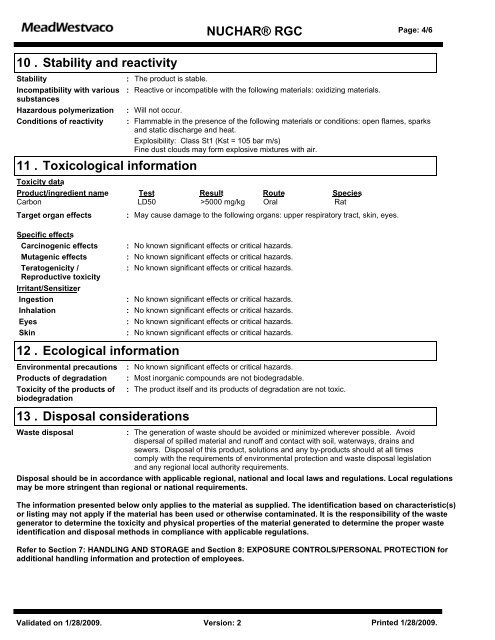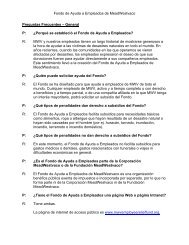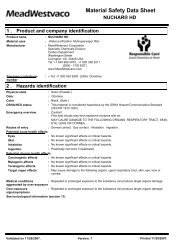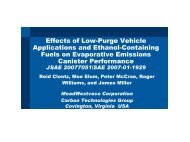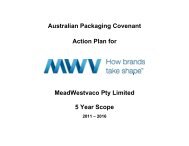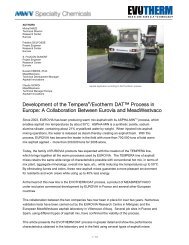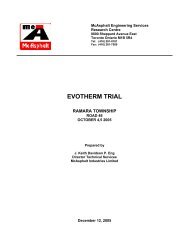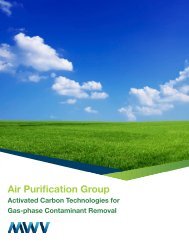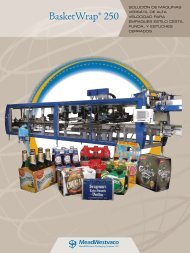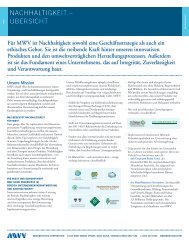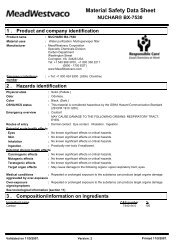NUCHAR® RGC - MeadWestvaco
NUCHAR® RGC - MeadWestvaco
NUCHAR® RGC - MeadWestvaco
Create successful ePaper yourself
Turn your PDF publications into a flip-book with our unique Google optimized e-Paper software.
10 .<br />
Stability and reactivity<br />
<strong>NUCHAR®</strong> <strong>RGC</strong><br />
Page: 4/6<br />
Stability<br />
: The product is stable.<br />
Incompatibility with various<br />
substances<br />
: Reactive or incompatible with the following materials: oxidizing materials.<br />
Hazardous polymerization : Will not occur.<br />
Conditions of reactivity : Flammable in the presence of the following materials or conditions: open flames, sparks<br />
and static discharge and heat.<br />
Explosibility: Class St1 (Kst = 105 bar m/s)<br />
Fine dust clouds may form explosive mixtures with air.<br />
11 .<br />
Toxicological information<br />
Toxicity data<br />
Product/ingredient name Test Result Route Species<br />
Carbon LD50 >5000 mg/kg Oral Rat<br />
Target organ effects : May cause damage to the following organs: upper respiratory tract, skin, eyes.<br />
Specific effects<br />
Carcinogenic effects : No known significant effects or critical hazards.<br />
Mutagenic effects : No known significant effects or critical hazards.<br />
Teratogenicity /<br />
Reproductive toxicity<br />
Irritant/Sensitizer<br />
: No known significant effects or critical hazards.<br />
Ingestion : No known significant effects or critical hazards.<br />
Inhalation : No known significant effects or critical hazards.<br />
Eyes : No known significant effects or critical hazards.<br />
Skin : No known significant effects or critical hazards.<br />
12 .<br />
Ecological information<br />
Environmental precautions : No known significant effects or critical hazards.<br />
Products of degradation : Most inorganic compounds are not biodegradable.<br />
Toxicity of the products of<br />
biodegradation<br />
: The product itself and its products of degradation are not toxic.<br />
13 .<br />
Disposal considerations<br />
Waste disposal<br />
: The generation of waste should be avoided or minimized wherever possible. Avoid<br />
dispersal of spilled material and runoff and contact with soil, waterways, drains and<br />
sewers. Disposal of this product, solutions and any by-products should at all times<br />
comply with the requirements of environmental protection and waste disposal legislation<br />
and any regional local authority requirements.<br />
Disposal should be in accordance with applicable regional, national and local laws and regulations. Local regulations<br />
may be more stringent than regional or national requirements.<br />
The information presented below only applies to the material as supplied. The identification based on characteristic(s)<br />
or listing may not apply if the material has been used or otherwise contaminated. It is the responsibility of the waste<br />
generator to determine the toxicity and physical properties of the material generated to determine the proper waste<br />
identification and disposal methods in compliance with applicable regulations.<br />
Refer to Section 7: HANDLING AND STORAGE and Section 8: EXPOSURE CONTROLS/PERSONAL PROTECTION for<br />
additional handling information and protection of employees.<br />
Validated on 1/28/2009.<br />
Version: 2 Printed 1/28/2009.


